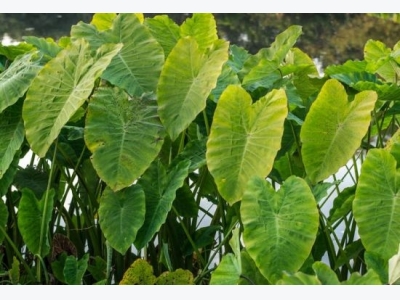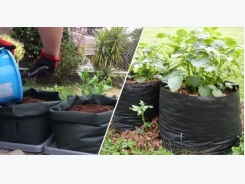When to Plant Elephant Ear Bulbs

Colocasia, also known as elephant ears or taro, make spectacular landscaping plants. Their long stalks and large, luxurious leaves add a tropical feel to any garden setting. They also come in a variety of colors, from deep green to purple or black.
Native to Asia, Colocasias are only winter hardy to U.S.D.A. Plant Hardiness Zones 7B-8B, depending on the variety. If you’re lucky enough to live within these zones, you can enjoy Colocasias outdoors year-round. If cold weather threatens, a layer of mulch is usually enough to protect them.
PLANTING ELEPHANT EAR BULBS
Northern gardeners longing for something exotic can still enjoy elephant ears. The secret is to plant them outdoors in the spring and bring them back indoors again come fall. Read on to learn how:
Select a sunny location in your garden after nighttime temperatures are reliably above 50 degrees and daytime temperatures remain about 70 degrees. Amend the soil with 2 inches of compost or manure. Elephant ears prefer a soil pH between 5.5 and 7.0. Add a little lime to sweeten acidic soil or add sulphur to lower your soil’s pH.
Dig a hole 2-4 inches larger than the elephant ear bulb. Place the bulb in the hole with the flat end pointing down. Cover the bulb with soil and firm lightly.
Water the bulb regularly to keep the soil evenly moist. Since colocasias are tropical plants, they’re used to warm, moist conditions and fertile soil. Do not allow the plants to dry out between watering.
Fertilize your elephant ear plant once a month with a balanced fertilizer.
Cut back any leaves that turn brown or straggly.
Reduce watering as temperatures drop in the fall. After the first light frost, trim back the leaves to ½ inch above the bulb. Gently dig up the bulb, which may have produced a cluster of bulbs over the summer. Don’t separate the bulbs and be careful not to nick them, which can promote disease.
Place the bulbs in a dry, shady place outdoors for a day or two to allow them to dry out completely. Tuck them in a bit of sphagnum moss or a paper bag and store them indoors for the winter in a cool, dark spot. Come spring plant them again and the process starts anew.
TIPS FOR SUCCESS
Read up on the needs of your specific variety. Some colocasias prefer very wet conditions and may even sit in an inch or two of water, such as at the edge of a pond or water feature. Others prefer a bit more shade.
If you live in a dry, hot area, plant elephant ears where they’ll get more shade. In cool Northern climes, they thrive in full sun.
Elephant ears range in size from 9 inches to over 9 feet. Make sure you leave plenty of space for your plant to spread out in the garden.
All parts of the Colocasias are edible when thoroughly cooked. In fact, taro is one of the most common vegetables eaten in the world. But beware: Raw leaves and stems contain calcium oxalate, the same poisonous substance found in rhubarb and Dieffenbachia. Wear gloves and avoid touching your eyes when cutting or handling elephant ear bulbs and plants, and keep them away from children and pets.
GROWING ELEPHANT EAR PLANTS IN POTS
If you’d rather not deal with the bulbs, another option is to grow elephant ears as a potted plant. You can keep it indoors year-round, or you can put it outdoors in spring and bring it back indoors in the fall.
As fall approaches, move your potted elephant ear plant to a shady, cool location outdoors. Reduce watering to nudge the plant into dormancy. Cut the leaves 1 to 2 inches above the soil. Bring the elephant ear indoors before the first heavy frost and keep it in a cool, dry location. Water it occasionally, but avoid overwatering it or fertilizing it during the winter. Come spring, start watering it more regularly and apply a balanced houseplant fertilizer.
Related news
Tools

Phối trộn thức ăn chăn nuôi

Pha dung dịch thủy canh

Định mức cho tôm ăn

Phối trộn phân bón NPK

Xác định tỷ lệ tôm sống

Chuyển đổi đơn vị phân bón

Xác định công suất sục khí

Chuyển đổi đơn vị tôm

Tính diện tích nhà kính

Tính thể tích ao



 Are Elephant Ear Plants Poisonous?
Are Elephant Ear Plants Poisonous?  Growing Potatoes in Containers: A Roundup of the…
Growing Potatoes in Containers: A Roundup of the…